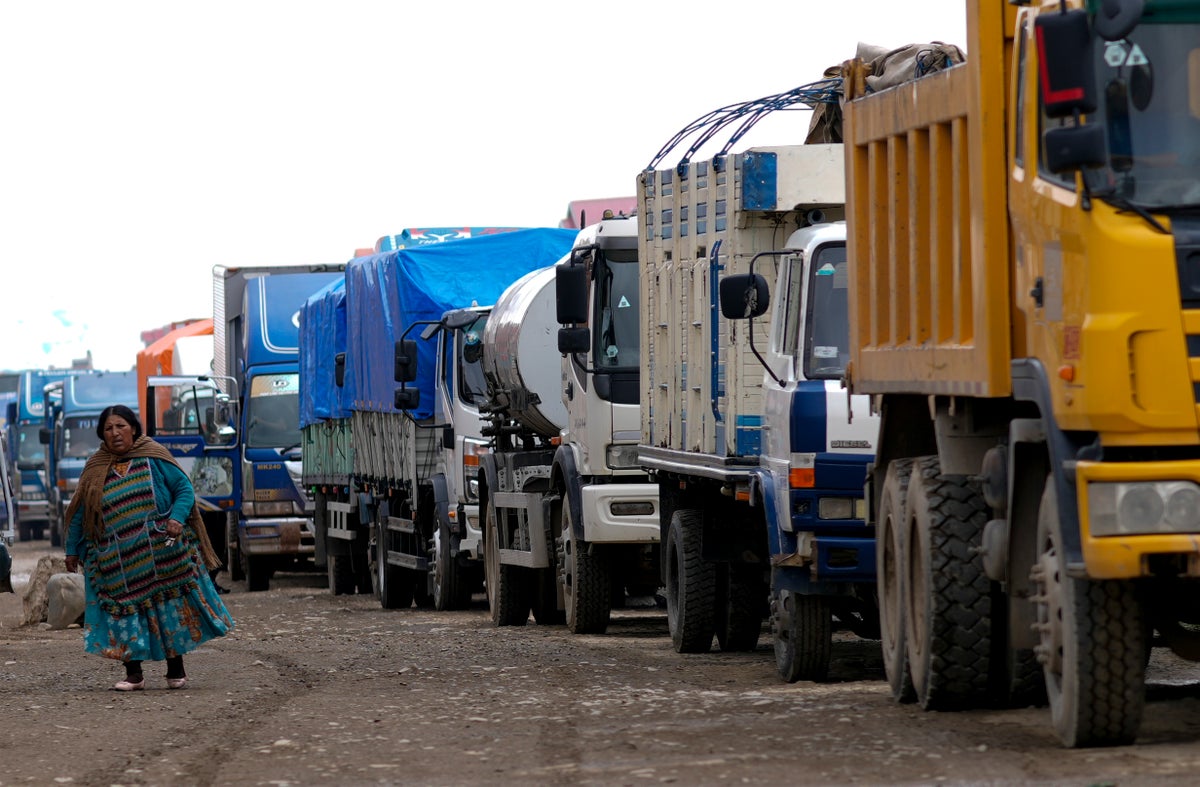
Fuel is rapidly becoming one of Bolivia’s scarcest commodities.
Long lines of vehicles snake for several kilometers outside gas stations all over Bolivia, once South America’s second-largest producer of natural gas. Some of the queues don’t budge for days.
While frustration builds, drivers like Victor García now eat, sleep and socialize around their stationary trucks, waiting to buy just a few gallons of diesel — unless the station runs dry.
“We don’t know what’s going to happen, but we’re going to be worse off," said García, 66, who inched closer to the pump Tuesday as the hours ticked by in El Alto, a bare-bones sprawl beside Bolivia's capital in the Andean altiplano.
Bolivia's monthslong fuel crunch comes as the nation's foreign currency reserves plummet, leaving Bolivians unable to find U.S. dollars at banks and exchange houses. Imported goods that were once commonplace have become scarce.
The fuel crisis has created a sense that the country is coming undone, disrupting economic activity and everyday life for millions of people, hurting commerce and farm production and sending food prices soaring.
Mounting public anger has driven crowds into the streets in recent weeks, piling pressure on leftist President Luis Arce to ease the suffering ahead of a tense election next year.
“We want effective solutions to the shortage of fuel, dollars and the increase in food prices,” said Reinerio Vargas, the vice rector of Gabriel René Moreno Autonomous University in the eastern province of Santa Cruz, where hundreds of desperate truckers and residents flooded main squares Tuesday to vent their anger at Arce’s inaction and demand early elections.
In a similar eruption of discontent, protesters shouting “Everything is expensive!” marched through the streets of the capital, La Paz, last week.
Bolivians say Arce's image has suffered not only because of the crisis but also because his government insists that it doesn't exist.
“Diesel sales are in the process of returning to normal,” Economy Minister Marcelo Montenegro said Tuesday.
Arce has repeatedly vowed that his government will end the fuel shortages and lower the prices of basic goods by arbitrary deadlines. On Nov. 10, he again promised he would “resolve this issue” in 10 days.
As the deadlines come and go, the black market currency exchange rate has risen to nearly 40% more than the official rate.
Arce's office did not respond to interview requests.
“The queues are getting longer and longer,” said 38-year-old driver Ramiro Morales, who needed a bathroom after four hours in line Tuesday but feared losing his place if he went searching for one. “People are exhausted.”
It’s a shocking turnaround for the landlocked nation of 12 million people that was a South American economic success story in the 2000s, when the commodities bonanza generated tens of billions of dollars under the nation’s first Indigenous president, former President Evo Morales.
Morales, Arce’s one-time mentor, is his present-day rival in the fight to be the ruling party’s candidate next year.
But when the commodities boom ended, prices slumped and gas production dwindled. Now, Bolivia spends an estimated $56 million a week to import most of its gasoline and diesel from Argentina, Paraguay and Russia.
Economy Minister Montenegro on Tuesday pledged that the government would continue providing fuel subsidies that critics say it can’t afford.
Banners from two years ago boasting that Bolivia’s inflation is the lowest in South America still greet tourists arriving at El Alto International Airport. Now, inflation is among the highest in the region.
Fuel shortages prevent farmers from getting their produce to distribution centers and markets, triggering a sharp price hike for food staples.
Last week in La Paz and neighboring El Alto, hungry Bolivians jostled in long lines to buy rice after much-delayed shipments finally arrived from Santa Cruz, the country's economic engine some 850 kilometers (528 miles) away.
With the diesel shortage affecting everything from the operation of tractors to the sourcing of machinery parts, the shortage is also hurting farmers during the crucial planting season.
“Without diesel, there is no food for 2025,” said Klaus Frerking, the vice president of the Eastern Agricultural Chamber of Bolivia.
The prices of potatoes, onions and milk have doubled in El Alto’s main wholesale food market in the past month, vendors said, overshooting the country’s nearly 8% inflation rate.
Nervous Bolivians are cutting back on their consumption.
“You have to search a lot to find the cheapest food,” said 67-year-old Angela Mamani, struggling to pull together meals for her six grandchildren at El Alto's open-air market Tuesday. She planned to buy vegetables but didn’t have enough cash and went home empty-handed.
This week, Arce's government presented a 2025 budget — with a 12% increase in spending — that drew backlash from lawmakers and business leaders who said it would lead to more debt and more inflation.
While the governing Movement Toward Socialism party tears itself apart in the power struggle between Arce and Morales, both politicians have seen the economic morass as a way to strengthen their positions ahead of 2025 elections.
“They deny there are problems. They blame external contexts and conflicts,” said Bolivian economic analyst Gonzalo Chávez.
Morales' supporters last month launched 24-day protest partly targeting Arce’s handling of the economy that blocked main roads and stranded commercial shipments, costing the government billions of dollars.
Security forces broke up the rallies almost a month ago. But on Tuesday, Arce's government continued to blame Morales' blockades for spawning the ubiquitous fuel lines.
“We need change,” said Geanina García, a 31-year-old architect scouring the grocery hub of El Alto for cheap deals — a once-routine errand that she said had turned into a nightmare.
“People don’t live off politics, they live day to day, off of what they produce and what they earn.”
____
Follow AP’s coverage of Latin America and the Caribbean at https://apnews.com/hub/latin-america







